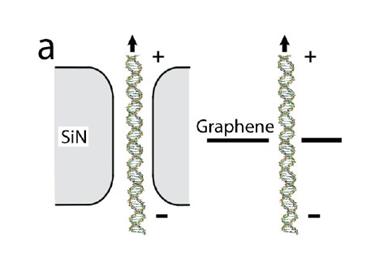Graphene Nanopores Solve DNA Sequencing Problem
There’s little doubt that it will be possible to sequence any individual’s genome quickly and cheaply within the next few years. But that’s not to say there aren’t significant technology challenges ahead before it can happen. And the biggest question is how it will be done.

Scientists have long known that strands of DNA are electrical conductors. However, the different structures of the four nucleotide bases that make up DNA– cytosine, guanine, adenine and thymine–indicate that each should have different electrical characteristics.
That leads to an interesting idea. If you can measure the electrical properties of each nucleotide base in a DNA strand, you could determine their sequence.
But how do you measure the electrical properties of a single subunit among many tens or hundreds of thousands?
One of the most promising ideas is to make a tiny hole through a thin sheet of material and measure the amount of current that passes from one side of the sheet to another.
Next, pull a strand of DNA through this hole and measure the current again. Any difference must be caused by the nucleotide base that happens to blocking the hole at that moment.
So measuring the way the current changes as you pull the strand through the hole gives you a direct reading of the sequence of nucleotide bases in the strand.
Simple really. Except for one small problem. Even the thinnest films of semiconducting materials used for this process, such as silicon nitride, are between 10 and 100 times thicker than the distance between two nucleotide bases on a strand of DNA.
So when a strand of DNA passes through the hole, it’s not a single nucleotide base that blocks it but as many as 100. That makes it hard to determine the sequence from any change in the current.
Today, Grégory Schneider and buddies at the Kavli Institute of Nanoscience in The Netherlands present a solution to this problem. Instead of a conventional material, this team has used graphene, which is relatively easy to produce in sheets just a single atom thick.
Graphene is like a sheet of chicken wire made of carbon atoms. These guys have drilled holes of various diameters through just such a sheet using an electron beam to smash carbon atoms out of the structure.
As with previous nanopore experiments, they measured the current that flows from one side of the sheet to the other when a hole is both empty and blocked by a strand of DNA.
Sure enough, in these proof of principle experiments, the difference allowed them to determine when a strand of DNA was present or when two or more strands were stuck in the nanopore.
That’s as far as they’ve got so far. But the significant point is that the graphene sheet is so thin that when a strand of DNA passes through it, only a single nucleotide base can block it an any instant.
What they’ll need to do next is to improve the sensitivity of their measurements to reliably determine the difference in electrical characteristics between one nucleotide base and another. That will be fiddly but it provides to a clear route forward.
The Dutch group now join a cutthroat race to produce the first nanopore translocation sequencer. They’re up against teams from Harvard, Oxford and elsewhere who are all vying to master this trick and who have a few years head start.
The dream is to produce a device capable of sequencing a human genome in a time measured in minutes and at a cost measured in pennies.
But the ability to master graphene gives the Dutch team an interesting advantage. They can expect their phones to be ringing with more than a few offers of collaboration.
Ref: arxiv.org/abs/1005.4754: DNA Translocation through Graphene Nanopores
Keep Reading
Most Popular
Large language models can do jaw-dropping things. But nobody knows exactly why.
And that's a problem. Figuring it out is one of the biggest scientific puzzles of our time and a crucial step towards controlling more powerful future models.
The problem with plug-in hybrids? Their drivers.
Plug-in hybrids are often sold as a transition to EVs, but new data from Europe shows we’re still underestimating the emissions they produce.
How scientists traced a mysterious covid case back to six toilets
When wastewater surveillance turns into a hunt for a single infected individual, the ethics get tricky.
Google DeepMind’s new generative model makes Super Mario–like games from scratch
Genie learns how to control games by watching hours and hours of video. It could help train next-gen robots too.
Stay connected
Get the latest updates from
MIT Technology Review
Discover special offers, top stories, upcoming events, and more.